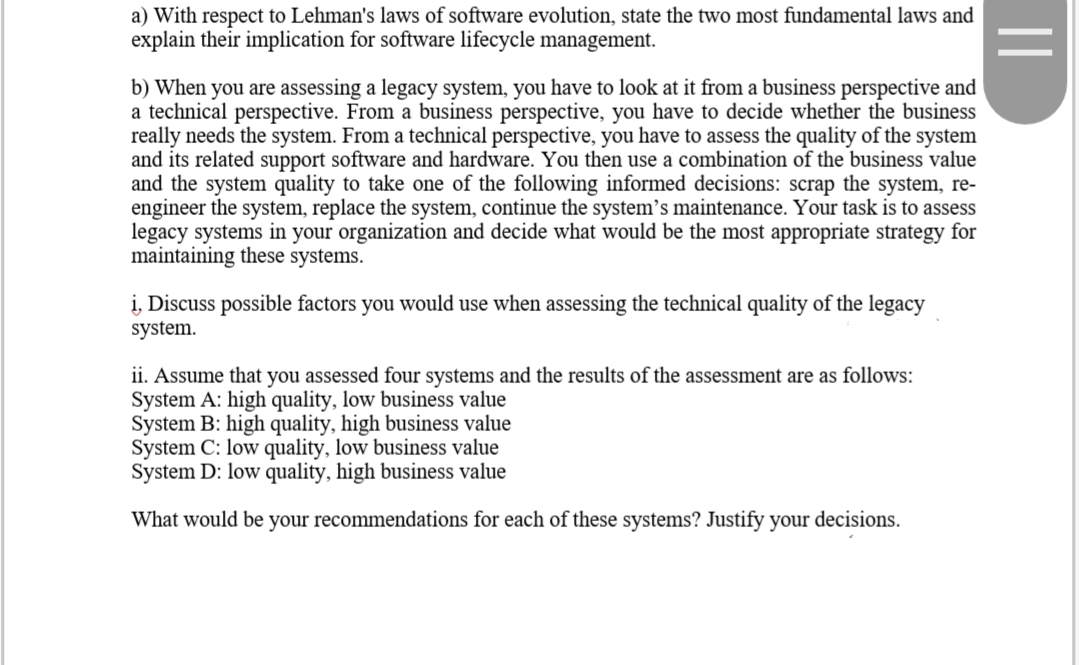a) With respect to Lehman's laws of software evolution, state the two most fundamental laws and explain their implication for software lifecycle management. b) When you are assessing a legacy system, you have to look at it from a business perspective and a technical perspective. From a business perspective, you have to decide whether the business really needs the system. From a technical perspective, you have to assess the quality of the system and its related support software and hardware. You then use a combination of the business value and the system quality to take one of the following informed decisions: scrap the system, re- engineer the system, replace the system, continue the system's maintenance. Your task is to assess legacy systems in your organization and decide what would be the most appropriate strategy for maintaining these systems. i, Discuss possible factors you would use when assessing the technical quality of the legacy system. ii. Assume that you assessed four systems and the results of the assessment are as follows: System A: high quality, low business value
a) With respect to Lehman's laws of software evolution, state the two most fundamental laws and explain their implication for software lifecycle management. b) When you are assessing a legacy system, you have to look at it from a business perspective and a technical perspective. From a business perspective, you have to decide whether the business really needs the system. From a technical perspective, you have to assess the quality of the system and its related support software and hardware. You then use a combination of the business value and the system quality to take one of the following informed decisions: scrap the system, re- engineer the system, replace the system, continue the system's maintenance. Your task is to assess legacy systems in your organization and decide what would be the most appropriate strategy for maintaining these systems. i, Discuss possible factors you would use when assessing the technical quality of the legacy system. ii. Assume that you assessed four systems and the results of the assessment are as follows: System A: high quality, low business value
Computer Networking: A Top-Down Approach (7th Edition)
7th Edition
ISBN:9780133594140
Author:James Kurose, Keith Ross
Publisher:James Kurose, Keith Ross
Chapter1: Computer Networks And The Internet
Section: Chapter Questions
Problem R1RQ: What is the difference between a host and an end system? List several different types of end...
Related questions
Question
100%

Transcribed Image Text:a) With respect to Lehman's laws of software evolution, state the two most fundamental laws and
explain their implication for software lifecycle management.
b) When you are assessing a legacy system, you have to look at it from a business perspective and
a technical perspective. From a business perspective, you have to decide whether the business
really needs the system. From a technical perspective, you have to assess the quality of the system
and its related support software and hardware. You then use a combination of the business value
and the system quality to take one of the following informed decisions: scrap the system, re-
engineer the system, replace the system, continue the system's maintenance. Your task is to assess
legacy systems in your organization and decide what would be the most appropriate strategy for
maintaining these systems.
i, Discuss possible factors you would use when assessing the technical quality of the legacy
system.
ii. Assume that you assessed four systems and the results of the assessment are as follows:
System A: high quality, low business value
System B: high quality, high business value
System C: low quality, low business value
System D: low quality, high business value
What would be your recommendations for each of these systems? Justify your decisions.
||
Expert Solution
This question has been solved!
Explore an expertly crafted, step-by-step solution for a thorough understanding of key concepts.
This is a popular solution!
Trending now
This is a popular solution!
Step by step
Solved in 4 steps

Recommended textbooks for you

Computer Networking: A Top-Down Approach (7th Edi…
Computer Engineering
ISBN:
9780133594140
Author:
James Kurose, Keith Ross
Publisher:
PEARSON

Computer Organization and Design MIPS Edition, Fi…
Computer Engineering
ISBN:
9780124077263
Author:
David A. Patterson, John L. Hennessy
Publisher:
Elsevier Science

Network+ Guide to Networks (MindTap Course List)
Computer Engineering
ISBN:
9781337569330
Author:
Jill West, Tamara Dean, Jean Andrews
Publisher:
Cengage Learning

Computer Networking: A Top-Down Approach (7th Edi…
Computer Engineering
ISBN:
9780133594140
Author:
James Kurose, Keith Ross
Publisher:
PEARSON

Computer Organization and Design MIPS Edition, Fi…
Computer Engineering
ISBN:
9780124077263
Author:
David A. Patterson, John L. Hennessy
Publisher:
Elsevier Science

Network+ Guide to Networks (MindTap Course List)
Computer Engineering
ISBN:
9781337569330
Author:
Jill West, Tamara Dean, Jean Andrews
Publisher:
Cengage Learning

Concepts of Database Management
Computer Engineering
ISBN:
9781337093422
Author:
Joy L. Starks, Philip J. Pratt, Mary Z. Last
Publisher:
Cengage Learning

Prelude to Programming
Computer Engineering
ISBN:
9780133750423
Author:
VENIT, Stewart
Publisher:
Pearson Education

Sc Business Data Communications and Networking, T…
Computer Engineering
ISBN:
9781119368830
Author:
FITZGERALD
Publisher:
WILEY